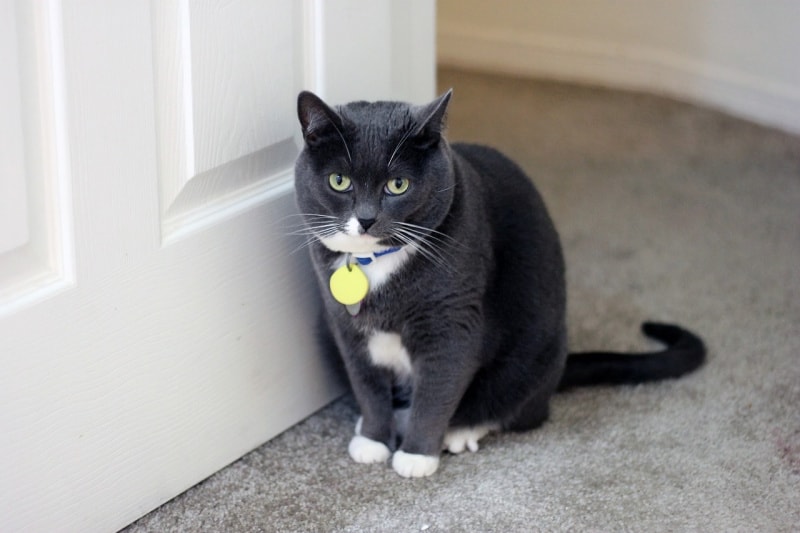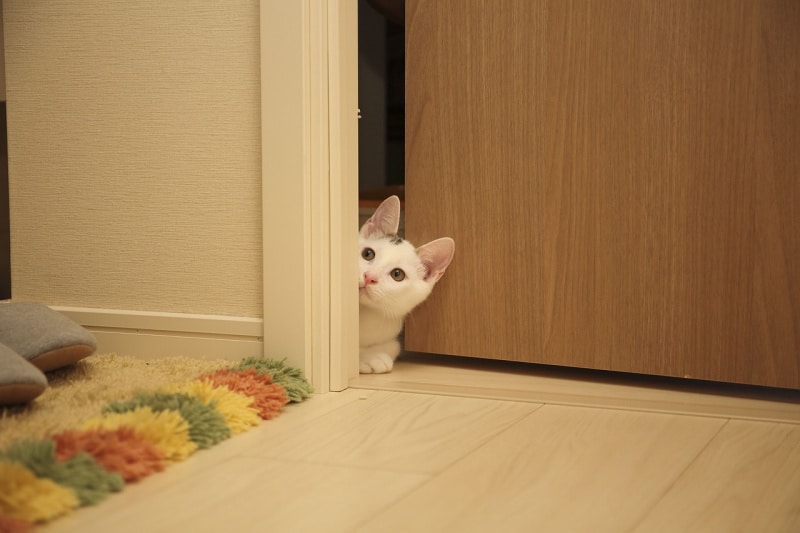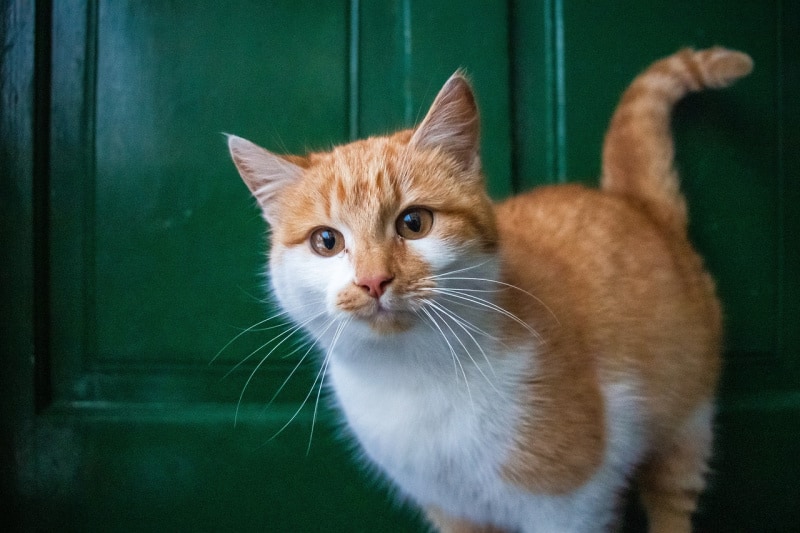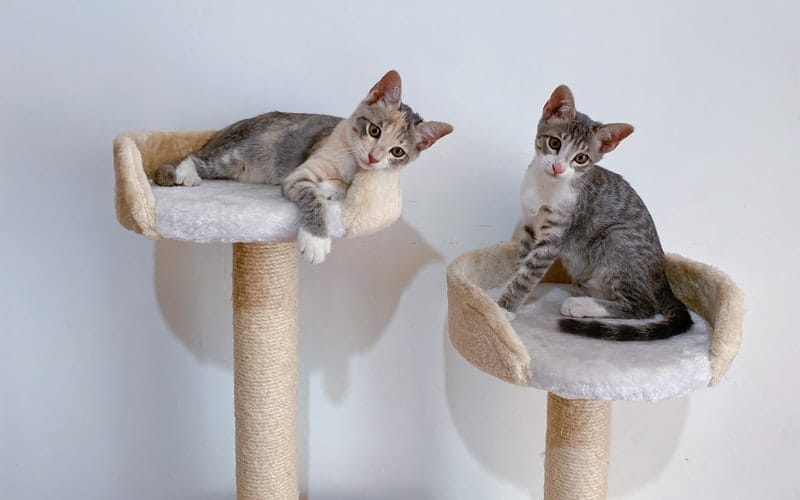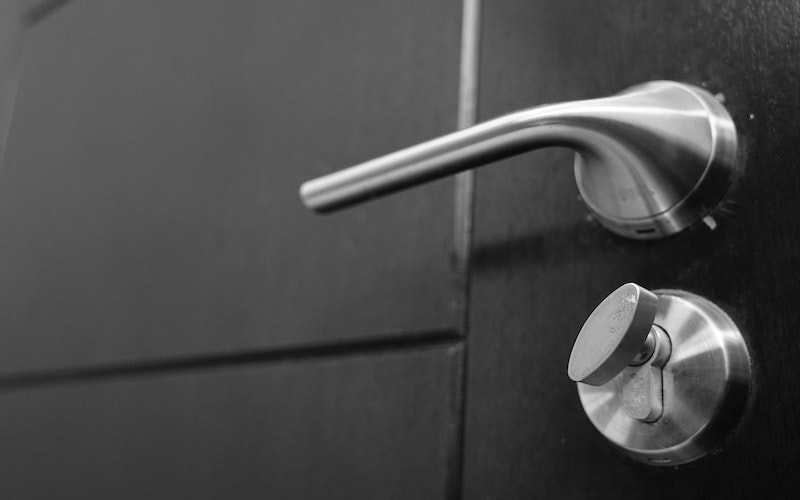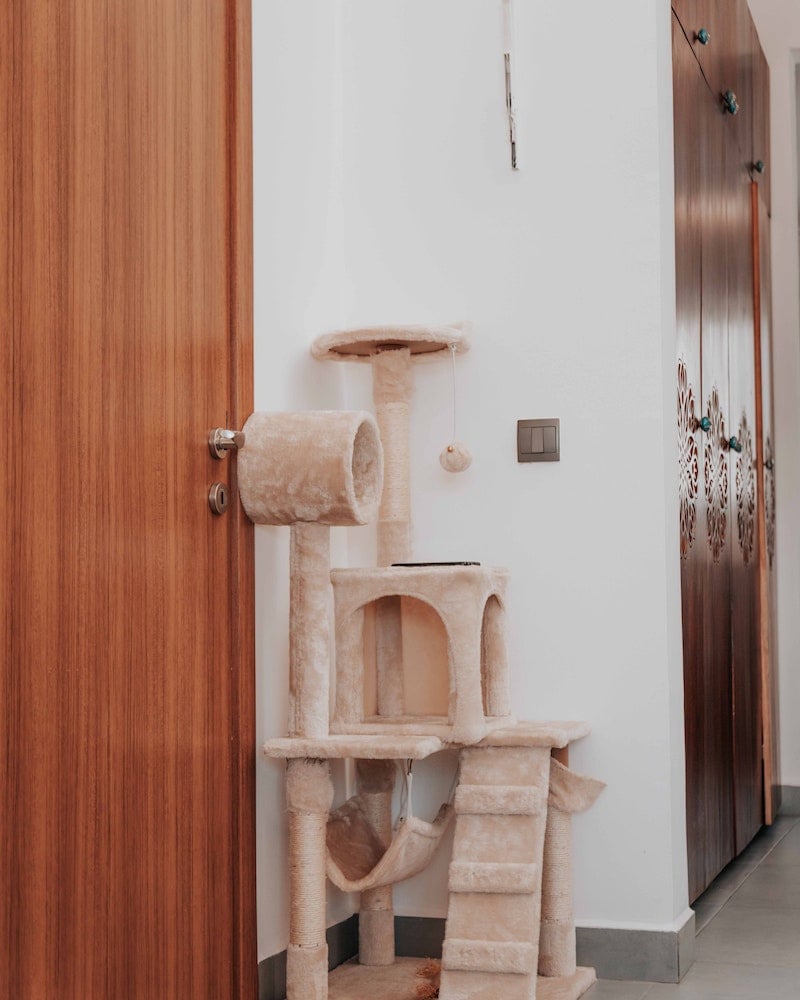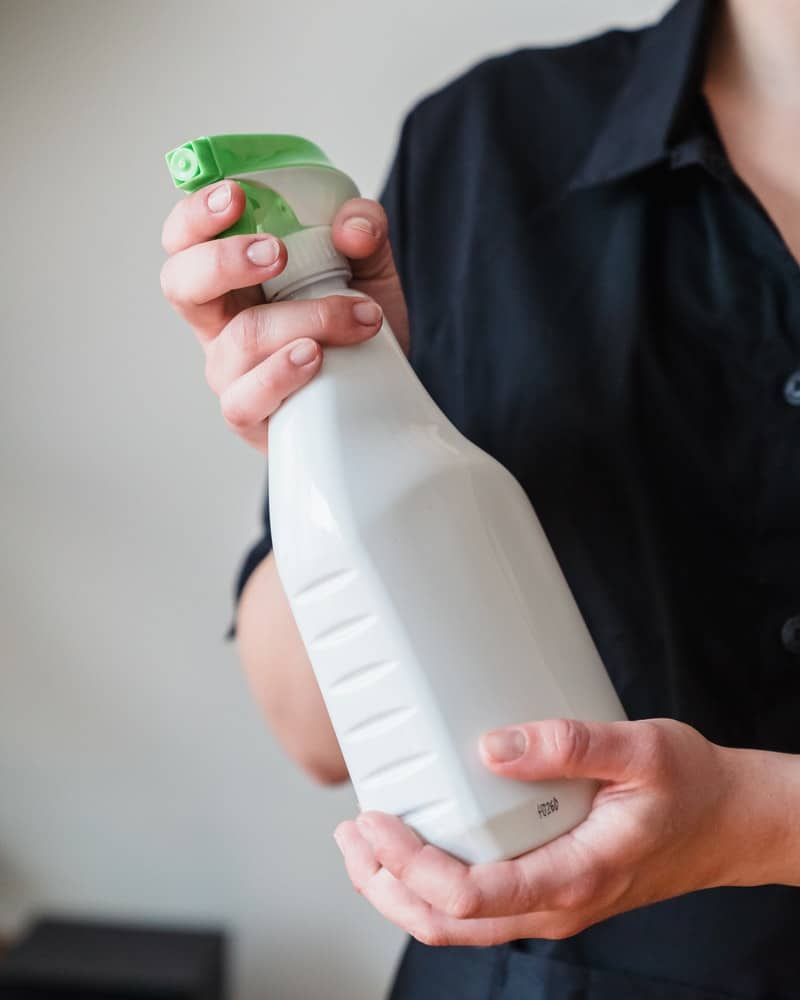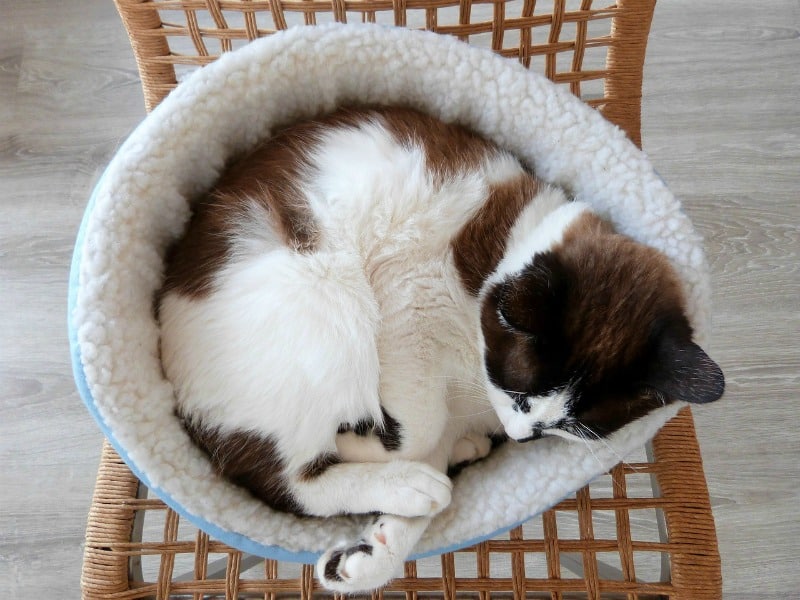Last Updated on September 9, 2023 by ellen
Learn how to stop cats from opening doors. Check out these tips pet owners can use to effectively stop pets from opening doors.
Posts may be sponsored. This post contains affiliate links, which means I will make a commission at no extra cost to you should you click through and make a purchase. As an Amazon Associate I earn from qualifying purchases.
Table of Contents
How to Stop Cats from Opening Doors
As a pet owner, your primary concern is likely the safety and well-being of your furry friends. Cats, known for their curiosity and agility, often find ways to open doors, leading to potential risks. While this behavior might initially seem amusing, it can lead to dangerous situations, especially if there are areas in your home that aren’t cat-friendly or if your cat manages to escape outside.
Keeping cats safe is a continuous task that requires vigilance and a bit of creativity. Doors present a fascinating challenge for your cat, but it’s a challenge that can be met with the right strategies. It’s not about limiting their curiosity, but rather directing it in a safe and engaging way within the bounds of your home.
In the following sections, I’ll break down simple and effective methods to prevent your cats from opening doors. These strategies are designed to be easy to implement, even for busy pet owners. By taking these steps, you can ensure the safety of your cats, giving you peace of mind and giving them a secure environment to explore.
Can cats open doors?
Yes, cats are capable of opening certain types of doors. While most traditional knob doors, if properly shut, pose a significant obstacle for cats, other door types present less of a challenge.
For instance, lever doors can be relatively easy for cats to operate with a well-timed jump and a bit of dexterity. Similarly, sliding doors, if not entirely closed, can be nudged open by a determined feline.
It’s important to remember that cats are agile and curious creatures, and their ability to open doors ultimately depends on the design of the door and the persistence of the cat.
Why does my cat keep trying to open doors?
Cats, by nature, are curious creatures and their behavior is often driven by this innate sense of wonder. If a door is closed, it represents a barrier to exploration, and cats instinctively want to see what’s behind it. Your cat isn’t necessarily trying to escape; rather, it’s just intrigued by the unknown. This curiosity is a key part of a cat’s cognitive health and mental stimulation.
In some cases, your cat may also be trying to open a door due to separation anxiety. Cats are social creatures, and being isolated from their owners can cause them distress. If your cat is constantly trying to open a door to reach you, it may be expressing loneliness or anxiety. It’s important to spend quality time with your cat to alleviate these feelings.
Additionally, your cat may be trying to access resources or favorite spots behind the door. This could be anything from a comfy patch of sunlight to a favorite toy or even a food source. If your cat associates a specific area behind a closed door with positive experiences, it’ll likely try to access it repeatedly. Managing your cat’s environment and establishing consistent routines can help control this behavior.
How do you keep an indoor cat inside?
Keeping an indoor cat inside involves creating a stimulating environment, ensuring their basic needs are met, and taking precautions with doors and windows.
The first measure is to make your home enticing for your cat. Include plenty of toys, scratching posts, and interactive items. Using cat trees or shelves, you can create vertical spaces for your cat to explore. Rotating toys and introducing new ones periodically can also keep your cat engaged.
Meeting your cat’s basic needs is paramount. This includes providing a balanced diet, maintaining a clean litter box, and making fresh water available. Regular play sessions and interactions can fulfill your cat’s social needs and discourage any desire to venture outside.
Lastly, be vigilant with doors and windows. Consider installing screens or netting on windows and balconies. Child-proof locks or doorway gates can help secure doors. Remember to be cautious when entering or leaving the house to prevent your cat from darting out. Training your cat to stay away from open doors can also be beneficial.
Change your door handle
One effective method to prevent your cat from opening doors is by switching your door handles. If you currently have a lever handle door, consider changing it to a round or oval knob. Lever handles can be quite easy for cats to manipulate, especially if they have observed humans doing so. In contrast, round or oval knobs are more challenging for cats to grip and turn, making them a better choice for pet owners.
Making this change doesn’t require much technical skill. You can find various types of round or oval knobs in home improvement stores or online. Follow the manufacturer’s instructions to replace the lever handle with the new knob. It may take a bit of time and patience, but it’s a small investment for the peace of mind knowing your cat won’t be able to open doors and potentially put themselves at risk.
Use double sided tape on the door edges
Another deterrent for cats is the use of double-sided tape on the edges of your doors. Cats typically dislike the sensation of sticky surfaces on their paws. By sticking tape along the edges of the door, you create a tactile obstacle that they’d rather avoid.
This will discourage them from trying to open the door. The beauty of this method is its simplicity and ease. Putting double sided tape on a door takes just a few minutes.
Over time, your cat will associate the unpleasant stickiness with the act of trying to open doors, leading to a reduction in the behavior. Remember to replace the tape regularly to ensure its effectiveness.
If you don’t have double sided tape, you can use a piece of folded over duct tape instead.
Discourage scratching on the door
Cats often resort to door scratching due to a lack of appropriate outlets for their natural need to scratch. It’s crucial to offer your cat an alternative, such as a cat scratching post.
A scratching post serves multiple purposes: it provides an appropriate place for your cat to exercise their claws, it’s excellent for their physical health as it allows them to stretch their bodies, and it’s mentally stimulating. Place the scratching post near the door your cat typically targets. To lure your cat towards the post, you can sprinkle some catnip on it or attach a toy.
By offering an enticing alternative, you can effectively discourage your cat from scratching the door. Remember, patience and consistency are key in modifying your cat’s behavior. It might take time, but eventually, your cat will associate the post as their preferred scratching destination.
Childproof your door
If your feline friend persists in opening a door, installing a baby gate might be a practical solution. Baby gates are traditionally designed to keep toddlers safe, but they can also effectively serve as a barrier for your cat.
Position the baby gate in the door frame your cat frequently targets. They are typically easy to install and remove, requiring no permanent alterations to your home. It’s advisable to choose a gate with bars close enough together to prevent your cat from squeezing through.
This method maintains visual access and air circulation while keeping your curious cat from entering an off-limits area. Remember, the goal is to create a safe and satisfying environment for your cat, balancing their curiosity with their well-being.
It’s very important to prevent your cat from opening exterior doors. You don’t want them to open the front door and escape. Cat proofing can help prevent this safety risk.
Keep your door open
Keeping your door open can be beneficial for several reasons. First, it can promote a strong sense of openness and freedom in your home. Closed doors can sometimes give the impression of being restricted or confined. By simply leaving your doors open, you can encourage a more welcoming and inclusive atmosphere.
Secondly, keeping your doors open can be advantageous for improving air circulation. This is particularly crucial in warmer months when the heat can build up in closed-off rooms. An open door can facilitate a steady flow of air, enhancing the comfort and coolness of your living space.
Lastly, if you have pets, particularly cats, keeping doors open can help satisfy their natural curiosity without them resorting to scratching or attempting to open doors themselves. It can also provide them with more space to explore, play, and exercise, contributing to their overall well-being. Remember, the goal is to create a safe and satisfying environment where everyone, including your pets, can feel comfortable and at ease.
Homemade Cat Deterrent Sprays
Citrus Spray: Most cats dislike the smell of citrus fruits. You can make a simple citrus spray by squeezing the juice of an orange, lemon, or lime into a spray bottle, adding an equal part of water, and shaking it well. You can spritz this mixture around your doors to deter your cat.
Vinegar Spray: Vinegar is another scent disliked by cats. Mix equal parts of white vinegar and water in a spray bottle. Spray the mixture near the door, but make sure to test a small inconspicuous area first because of vinegar’s potential to discolor some materials.
Essential Oil Spray: Certain essential oils like eucalyptus, lavender, or citronella can be effective deterrents. Mix a few drops of the essential oil with water in a spray bottle. However, it’s crucial to use these oils in moderation, as high concentrations can be harmful to cats. Always consult with your vet before using essential oils as a deterrent.
Cat proof cabinet doors
Use Childproof Latches: Similar to doors, childproof latches can be installed on cabinets to prevent your cat from opening them. These latches are easily available and can be set up without much effort.
Install Magnetic Locks: Consider fitting your cabinets with magnetic locks. These latches are much more difficult to open.
Apply Double-sided Tape: Cats dislike sticky surfaces. Applying double-sided tape to the edges of the cabinet doors can deter your cat from trying to open them.
Use Bitter Apple Spray: Most cats dislike the taste of bitter apple. A quick spray on the corners of your cabinet doors can keep your cats away. Find it here.
Place Citrus Peels: Cats are repelled by the scent of citrus. Leaving a few citrus peels inside or around your cabinets can discourage your cat from snooping around them.
Keep cats away from screen doors
Use Pet-Proof Screens: Consider replacing your current screen with a pet-proof one. Pet-proof screens are made from more durable materials, which can resist the scratches and claw marks of your curious cat.
Install a Sisal Board: Cats love to scratch sisal material, making it an ideal distraction. Install a sisal board near your screen door to divert your cat’s attention and keep them away from the screen.
Training: Encourage positive behavior by rewarding your cat when they stay away from the screen door. This could be with treats or their favorite toy. With time and consistency, your cat will learn that staying away from the screen door earns them rewards.
Tips for pet owners
In conclusion, managing your feline friend’s exploration and curiosity in a safe and efficient manner will require a blend of creativity, patience, and understanding.
From childproofing doors to homemade deterrent sprays, there are several methods available to guide and control your cat’s behavior. The essential point is to create a living environment that is both satisfying for your pet and convenient for you.
Moreover, remember that every cat is unique with its own set of preferences and behaviors. The strategies that work wonders for one might not be as effective for another. Therefore, it’s always beneficial to experiment with different approaches and observe your cat’s reactions.
Don’t be discouraged if your initial efforts to keep your cat from opening doors aren’t successful. Patience is key, and with time, you’ll find the perfect balance that ensures a happy, healthy cat and a scratch-free home.
Related Reading
How to keep cats from scratching leather furniture

Ellen runs a small pet sitting business in southern Vermont. She has experience with a variety of small animals, dogs and cats. She has also cared for ducks, chickens and rabbits. Combined, she has over 20 years of experience in pet care and pet sitting.
